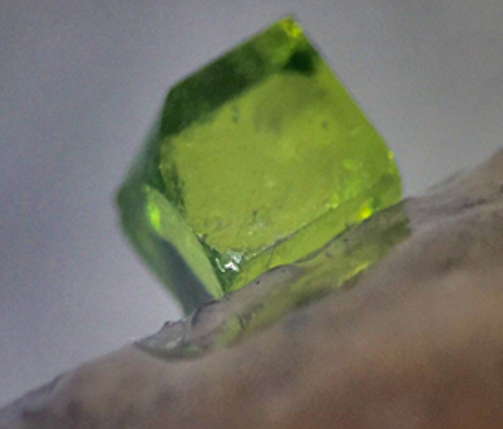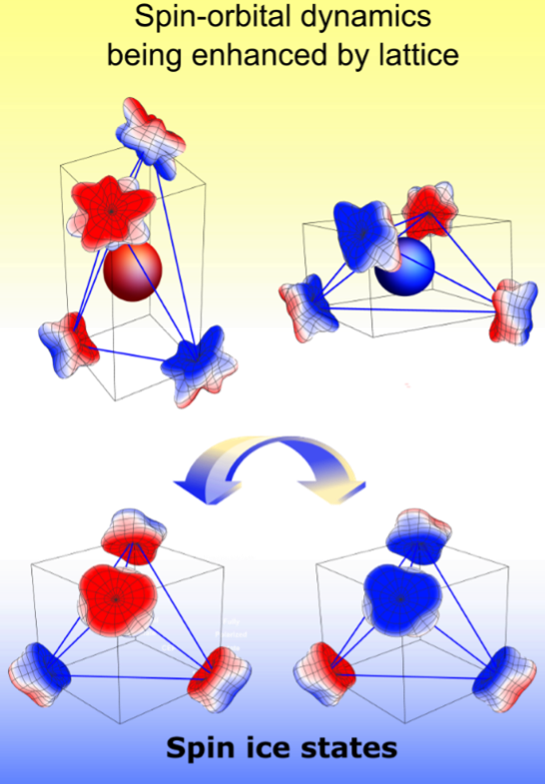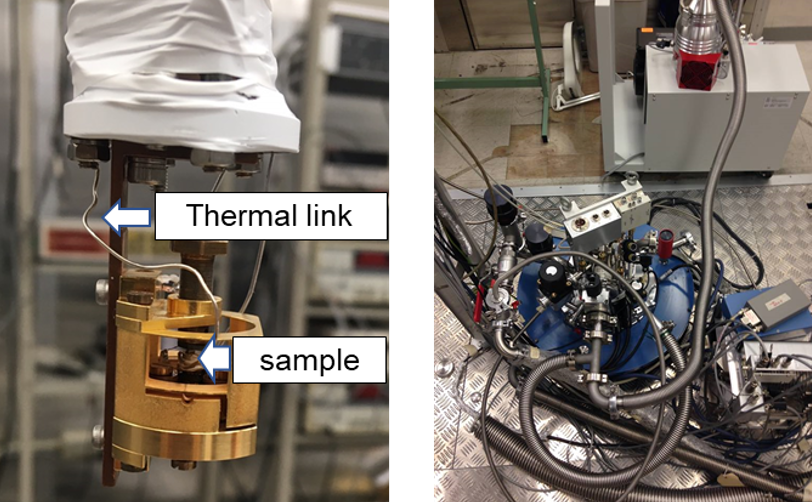DATE2022.12.02 #Press Releases
An exotic quantum state of matter
An international team of researchers observed an elusive state of matter called spin-orbital liquid formed in pyrochlore oxide, a rare-earth mineral, paving way for potential applications in next-generation quantum technologies.
December 02, 2022
Atoms are like mini magnets because of the electrons spinning in their orbitals, the regions around the nucleus. The spin of an atom is a quantum property that can only take specific values—like a compass always points in one direction. If the neighboring spins of the atoms align in the same directions, the material is ferromagnetic. Your fridge magnet, for example, aligns the unpaired electrons in the steel door, and the resulting force sticks them together. But some materials, called geometrically frustrated magnets, lack such orderly spins that align in the same or opposite directions. For example, pyrochlore crystal is a rare earth mineral with a three-dimensional lattice or network of magnetic atoms arranged in tetrahedral shapes. Pyrochlore is prone to geometric frustration, where the conflicting spins and orbitals of neighboring atoms interact, relentlessly fluctuate, and turn into a new quantum state of matter. But such a quantum state of matter has been elusive so far.
An international collaboration network led by Satoru Nakatsuji, a professor at the University of Tokyo proposed a way to realize the exotic state of matter, spin-orbital liquid, in the pyrochlore oxide Pr2Zr2O7, also known as a quantum spin ice candidate (Figure 1). In the quantum spin-orbital liquid state, the spins and orbitals of the atoms continuously fluctuate even at low temperatures (around -273°C) and remain ‘liquid’ inside a solid pyrochlore crystal. The team published their research in the latest issue of the journal Nature Physics.

Figure 1 : A piece of ultra-high quality green crystal sample of the cubic pyrochlore oxide Pr2Zr2O7 grown in the laboratory of Prof. Nakatsuji.
The spin-orbital liquid has been hard to realize because different physical laws govern spins and orbitals. Spins are magnetic, and orbitals are electric. In the presence of a magnetic field, the spins of the atoms align, but the orbitals are not affected as much. “Spins have low energy scales, so the spin-exchange interactions that drive them are also quite small. On the other hand, orbitals have shapes and therefore, are ‘pulled’ by the surrounding crystal lattice deformation into an ordered state. These orbital-lattice couplings have much higher energy than spin-exchange interactions. In this way, it is considered almost impossible to have high-energy orbitals and low-energy spins fluctuate simultaneously,” said Nan Tang, a PhD graduate at the University of Tokyo and an author of the research article.
Pr2Zr2O7 is a rare example where spins and orbitals are linked such that the fluctuation of one causes the other to fluctuate. The key to realizing the spin-orbital liquid is the even number of electrons in the 4f orbitals of the Pr3+ ions within the Pr2Zr2O7 lattice which leads to symmetry that allows the spin-orbital liquid to form. But for the formation of the spin-orbital liquid, the crystal needs to be of high quality. Even a small disorder can affect its physical properties.
The researchers succeeded in growing an extremely high-quality Pr2Zr2O7 crystal in the lab. They confirmed the quality through physical property measurements and crystallographic analyses to inspect the structure at the atomic level. Crystals, including your table salt, have defined structures (cubic in the case of salt) because of the arrangement of their constituent atoms. If the pattern of the structure persists beyond the interatomic distances, the crystal has a long-range order. The researchers showed that the spins and orbitals of Pr ions in the lowest energy state of Pr2Zr2O7 do not show long-range order even at -273°C, implying that they behave like a ‘liquid’. Theory suggests that the lattice structure of the crystal can also enhance the spin-orbital dynamics and stabilize the quantum spin ice state (Figure 2). The team used lattice-sensitive probes to show that the spin-orbital liquid state forms on the pyrochlore crystal lattice even at incredibly low temperatures and low magnetic fields (Figure 3). The findings may have promising applications in future quantum technologies.

Figure 2 : A schematic of spin-orbital dynamics enhanced by the lattice structure of the pyrochlore oxide Pr2Zr2O7. The bottom objects show two different configurations of spin ice states, where the red-to-blue gradient objects are the orbitals and spin components of Pr ions in the lowest energy state, located on the vertex of tetrahedrons. The top two objects are excited states that are distorted by lattice.

Figure 3 : Photos of low-temperature experimental apparatus. (Left) The scientists placed the sample crystal (Figure 1) inside an ultra-high-precision instrument called the dilatometer to measure thermal expansion and magnetostriction (change in the shape of magnetic material in the presence of an external magnetic field). A thermal link made from silver connects the sample to the coldest part of the dilution refrigerator. (Right) They used a dilution refrigerator to achieve the low temperatures (~ -273°C) necessary for the experiments on the quantum phenomenon.
The exotic state of matter emerges because of the spins and orbitals of the various interacting atoms. This is the essence of quantum many-body physics, where an unpredictable phenomenon emerges from individual interactions. The sum of the constituents cannot explain the emergent phenomenon of the whole. The quantum entanglement effect is a classic example in which light-years-apart subatomic particles can instantly interact as they are ‘entangled’. At the microscopic level, electron spins and orbitals can interact with each other so that the system cannot be defined by the sum of their spin and orbital interactions. So, the spin-orbital liquid embodies quantum many-body physics. Next-generation quantum technologies such as quantum computing and quantum cryptography are based on such phenomena.
“This research is expected to serve as a guideline for designing materials to further realize spin-orbit liquids in the future,” said Dr. Tang. “The exotic liquid is a macroscopic quantum state due to many-body entanglement and our work provides insights for manipulating the quantum entanglement effect,” added Prof. Nakatsuji.
Publication details
Journal Nature Physics Title Spin–orbital liquid state and liquid–gas metamagnetic transition on a pyrochlore latticeAuthors Nan Tang*, Yulia Gritsenko*, Kenta Kimura*, Subhro Bhattacharjee, Akito Sakai, Mingxuan Fu, Hikaru Takeda, Huiyuan Man, Kento Sugawara, Yosuke Matsumoto, Yasuyuki Shimura, Jiajia Wen, Collin Broholm, Hiroshi Sawa, Masashi Takigawa, Toshiro Sakakibara, Sergei Zherlitsyn, Joachim Wosnitza, Roderich Moessner and Satoru Nakatsuji
* These authors contributed equally.DOI
Podcast credits
Music: "Upbeat Forever" Kevin MacLeod (incompetech.com)
Podcast host: Ravindra Palavalli-Nettimi



